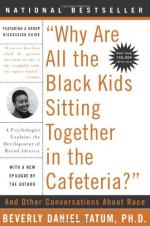
|
| Name: _________________________ | Period: ___________________ |
This test consists of 5 short answer questions, 10 short essay questions, and 1 (of 3) essay topics.
Short Answer Questions
1. In statistics and demography, what refers to a group of subjects who have shared a particular time together during a particular time span?
2. What refers to discrimination based on protected class status, variously including race, gender, ethnicity, age, national origin, sexual orientation and gender identity, marital status, or veteran status, in the realm of housing and real estate?
3. Who signed the Civil Rights Act of 1968?
4. What word means to incorporate the cultural values, mores, motives, etc., of another or of a group, as through learning, socialization, or identification?
5. William E. Cross, Jr. is a professor and head of the doctoral program in social-personality psychology at what institution?
Short Essay Questions
1. How does Tatum describe her conception of herself regarding race in Part II, Understanding Blackness in a White Context, Chapter 5, Racial Identity in Adulthood?
2. How does the author define prejudice in Part I, A Definition of Terms, Chapter 1, Defining Racism? What does revealing prejudice require?
3. How does Tatum relate prejudice to racism in Part I, A Definition of Terms, Chapter 1, Defining Racism?
4. What analysis of William Cross's does the author describe in Part II, Understanding Blackness in a White Context, Chapter 4, Identity Development in Adolescence?
5. What does Tatum say is a misconception parents have about their children in Part II, Understanding Blackness in a White Context, Chapter 3, The Early Years?
6. At what age does the author assert children begin to recognize race in Part II, Understanding Blackness in a White Context, Chapter 3, The Early Years? What does Tatum encourage parents to do at this stage?
7. How did Tatum feel about her experiences while in college, as discussed in Part II, Understanding Blackness in a White Context, Chapter 5, Racial Identity in Adulthood?
8. How does the author describe the formation of an oppositional identity in adolescent blacks in Part II, Understanding Blackness in a White Context, Chapter 4, Identity Development in Adolescence?
9. What does the author write in Part II, Understanding Blackness in a White Context, Chapter 3, The Early Years that she begins adult seminars with asking?
10. How does Tatum describe differences between men and women in racial identity in Part II, Understanding Blackness in a White Context, Chapter 4, Identity Development in Adolescence?
Essay Topics
Write an essay for ONE of the following topics:
Essay Topic 1
Discuss process-oriented and goal-oriented affirmative action as defined in the text. Toward what form of affirmative action does the author appear to lean?
Essay Topic 2
Discuss Tatum's examples of racial depictions from the Bible and in children's films. How do these early examples shape racial identity in children?
Essay Topic 3
Discuss the Nation of Islam, Christianity, and other religions and their impact on racial identity development. Why does the author assert black men are drawn to the Nation of Islam?
|
This section contains 959 words (approx. 4 pages at 300 words per page) |

|




